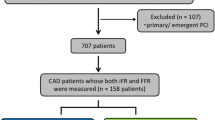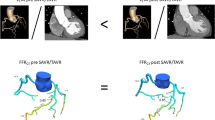Abstract
The reliability of fractional flow reserve (FFR) in aortic stenosis (AS) has been questioned because of the uncertain response to vasodilators. A retrospective multicenter cohort of 114 AS patients who underwent coronary physiology assessment was compared with 154 controls before and after propensity matching adjustment. The difference between resting distal coronary vs aortic pressure ratio (Pd/Pa) and FFR (ΔPd/Pa-FFR) was tested against the severity of AS. ΔPd/Pa-FFR was not influenced by the severity of AS in terms of aortic valve area (r = − 0.02, p = 0.83) and gradient (r = − 0.05, p = 0.64) or by the left ventricle hypertrophy (r = − 0.03, p = 0.88). Conversely, ΔPd/Pa-FFR was influenced by the presence of diabetes (r = − 0.24, p = 0.005), peripheral vascular disease (r = − 0.16, p = 0.047), and chronic kidney disease (r = − 0.19, p = 0.03). No significant difference was observed in the ΔPd/Pa-FFR between patients with AS and matched controls. Further studies are warranted to validate the FFR-guided revascularization in patients with AS.




Similar content being viewed by others
Abbreviations
- AS:
-
Aortic stenosis
- CAD:
-
Coronary artery disease
- CKD:
-
Chronic kidney disease
- DS:
-
Diameter stenosis
- FFR:
-
Fractional flow reserve
- iFR:
-
Instantaneous wave-free ratio
- LAD:
-
Left anterior descending artery
- LV:
-
Left ventricle
- Pd/Pa:
-
Distal vs proximal coronary pressure ratio
- QCA:
-
Quantitative coronary analysis
- TAVI:
-
Transcatheter aortic valve implantation
References
Tonino, P. A., De Bruyne, B., Pijls, N. H., Siebert, U., Ikeno, F., van’t Veer, M., et al. (2009). Fractional flow reserve versus angiography for guiding percutaneous coronary intervention. The New England Journal of Medicine, 360(3), 213–224.
De Bruyne, B., Pijls, N. H., Kalesan, B., Barbato, E., Tonino, P. A., Piroth, Z., et al. (2012). Fractional flow reserve-guided PCI versus medical therapy in stable coronary disease. The New England Journal of Medicine, 367(11), 991–1001.
Sen, S., Escaned, J., Malik, I. S., Mikhail, G. W., Foale, R. A., Mila, R., et al. (2012). Development and validation of a new adenosine-independent index of stenosis severity from coronary wave-intensity analysis: results of the ADVISE (ADenosine Vasodilator Independent Stenosis Evaluation) study. Journal of the American College of Cardiology, 59(15), 1392–1402.
Davies, J. E., Sen, S., Dehbi, H. M., Al-Lamee, R., Petraco, R., Nijjer, S. S., et al. (2017). Use of the instantaneous wave-free ratio or fractional flow reserve in PCI. The New England Journal of Medicine, 376(19), 1824–1834.
Götberg, M., Christiansen, E. H., Gudmundsdottir, I. J., Sandhall, L., Danielewicz, M., Jakobsen, L., et al. (2017). Instantaneous wave-free ratio versus fractional flow reserve to guide PCI. The New England Journal of Medicine, 376(19), 1813–1823.
Lumley, M., Williams, R., Asrress, K. N., Arri, S., Briceno, N., Ellis, H., et al. (2016). Coronary physiology during exercise and vasodilation in the healthy heart and in severe aortic stenosis. Journal of the American College of Cardiology, 68(7), 688–697.
Eberli, F. R., Ritter, M., Schwitter, J., Bortone, A., Schneider, J., Hess, O. M., et al. (1991). Coronary reserve in patients with aortic valve disease before and after successful aortic valve replacement. European Heart Journal, 12(2), 127–138.
Mahmod, M., Piechnik, S. K., Levelt, E., Ferreira, V. M., Francis, J. M., Lewis, A., et al. (2014). Adenosine stress native T1 mapping in severe aortic stenosis: evidence for a role of the intravascular compartment on myocardial T1 values. Journal of Cardiovascular Magnetic Resonance, 16, 92.
Baumgartner, H., Falk, V., Bax, J. J., De Bonis, M., Hamm, C., Holm, P. J., et al. (2017). 2017 ESC/EACTS guidelines for the management of valvular heart disease. European Heart Journal, 38(36), 2739–2791.
Scarsini, R., Pesarini, G., Zivelonghi, C., Piccoli, A., Ferrero, V., Lunardi, M., et al. (2017). Coronary physiology in patients with severe aortic stenosis: comparison between fractional flow reserve and instantaneous wave-free ratio. International Journal of Cardiology, 243, 40–46.
Scarsini, R., Pesarini, G., Zivelonghi, C., Piccoli, A., Ferrero, V., Lunardi, M., et al. (2018). Physiologic evaluation of coronary lesions using instantaneous wave-free ratio (iFR) in patients with severe aortic stenosis undergoing trans-catheter aortic valve implantation. EuroIntervention., 13(13), 1512–1519.
Di Gioia, G., Scarsini, R., Strisciuglio, T., De Biase, C., Zivelonghi, C., Franco, D., et al. (2017). Correlation between angiographic and physiologic evaluation of coronary artery Narrowings in patients with aortic valve stenosis. The American Journal of Cardiology, 120(1), 106–110.
Leon, M. B., Smith, C. R., Mack, M. J., Makkar, R. R., Svensson, L. G., Kodali, S. K., et al. (2016). Transcatheter or surgical aortic-valve replacement in intermediate-risk patients. The New England Journal of Medicine, 374(17), 1609–1620.
Reardon, M. J., Van Mieghem, N. M., Popma, J. J., Kleiman, N. S., Søndergaard, L., Mumtaz, M., et al. (2017). Surgical or Transcatheter aortic-valve replacement in intermediate-risk patients. The New England Journal of Medicine, 376(14), 1321–1331.
Neumann, F. J., Sousa-Uva, M., Ahlsson, A., Alfonso, F., Banning, A. P., Benedetto, U., et al. (2019). 2018 ESC/EACTS Guidelines on myocardial revascularization. European Heart Journal, 40(2), 87–165.
Pesarini, G., Scarsini, R., Zivelonghi, C., Piccoli, A., Gambaro, A., Gottin, L., et al. (2016). Functional assessment of coronary artery disease in patients undergoing transcatheter aortic valve implantation: influence of pressure overload on the evaluation of lesions severity. Circulation. Cardiovascular Interventions, 9(11) pii: e004088. https://doi.org/10.1161/CIRCINTERVENTIONS.116.004088
Yamanaka, F., Shishido, K., Ochiai, T., Moriyama, N., Yamazaki, K., Sugitani, A., et al. (2018). Instantaneous wave-free ratio for the assessment of intermediate coronary artery stenosis in patients with severe aortic valve stenosis: comparison with myocardial perfusion scintigraphy. JACC. Cardiovascular Interventions, 11(20), 2032–2040.
Di Gioia, G., Pellicano, M., Toth, G. G., Casselman, F., Adjedj, J., Van Praet, F., et al. (2016). Fractional flow reserve-guided revascularization in patients with aortic stenosis. The American Journal of Cardiology, 117(9), 1511–1515.
Danson, E., Hansen, P., Sen, S., Davies, J., Meredith, I., & Bhindi, R. (2016). Assessment, treatment, and prognostic implications of CAD in patients undergoing TAVI. Nature Reviews. Cardiology, 13(5), 276–285.
Ahmad, Y., Götberg, M., Cook, C., Howard, J. P., Malik, I., Mikhail, G., et al. (2018). Coronary hemodynamics in patients with severe aortic stenosis and coronary artery disease undergoing transcatheter aortic valve replacement: implications for clinical indices of coronary stenosis severity. JACC. Cardiovascular Interventions, 11(20), 2019–2031.
Kobayashi, Y., Johnson, N. P., Berry, C., De Bruyne, B., Gould, K. L., Jeremias, A., et al. (2016). The influence of lesion location on the diagnostic accuracy of adenosine-free coronary pressure wire measurements. JACC. Cardiovascular Interventions, 9(23), 2390–2399.
Gould, K. L., & Johnson, N. P. (2016). Ischemia in aortic stenosis: new insights and potential clinical relevance. Journal of the American College of Cardiology, 68(7), 698–701.
Stoller, M., Gloekler, S., Zbinden, R., Tueller, D., Eberli, F., Windecker, S., et al. (2018). Left ventricular afterload reduction by transcatheter aortic valve implantation in severe aortic stenosis and its prompt effects on comprehensive coronary haemodynamics. EuroIntervention., 14(2), 166–173.
Author information
Authors and Affiliations
Corresponding author
Ethics declarations
The local review board of other centers involved approved the study.
Conflict of Interest
Dr. Scarsini received an EAPCI education and training fellowship grant. Dr. Di Gioia is supported by CardioPaTh PhD program. Prof Banning received institutional funding for an interventional fellowship from Bosoton Scientific. Prof Banning is partially funded by the NHS NIHR Biomedical Reseach Centre, Oxford. Other authors have no conflict of interest to declare.
Human Subject/Informed Consent Statement
All procedures followed were in accordance with the ethical standards of the responsible committee on human experimentation (institutional and national) and with the Helsinki Declaration of 1975, as revised in 2000 [5]. Informed consent was obtained from all patients included in the study.
Additional information
Associate Editor Ana Barac oversaw the review of this article.
Publisher’s Note
Springer Nature remains neutral with regard to jurisdictional claims in published maps and institutional affiliations.
Electronic Supplementary Material
Supplementary figure 1.
Patient screening and selection. (PDF 43 kb)
Rights and permissions
About this article
Cite this article
Scarsini, R., De Maria, G.L., Di Gioia, G. et al. The Influence of Aortic Valve Obstruction on the Hyperemic Intracoronary Physiology: Difference Between Resting Pd/Pa and FFR in Aortic Stenosis. J. of Cardiovasc. Trans. Res. 12, 539–550 (2019). https://doi.org/10.1007/s12265-019-09890-5
Received:
Accepted:
Published:
Issue Date:
DOI: https://doi.org/10.1007/s12265-019-09890-5




